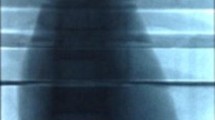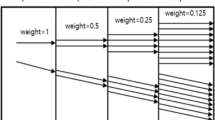Abstract
The purpose of this work was to investigate the differences in dose settings among the X-ray units involved in a national survey of patient doses in interventional radiology (IR). The survey was promoted by the National Society of IR and involved 10 centers. As part of the agreed quality control for the survey, entrance doses were measured in a 20-cm-thick acrylic phantom simulating a medium-sized patient. A standard digital subtraction angiography (DSA) imaging protocol for the abdomen was used at the different centers. The center of the phantom was placed at the isocenter of the C-arm system during the measurements to simulate clinical conditions. Units with image intensifiers and flat detectors were involved in the survey. Entrance doses for low, medium, and high fluoroscopy modes and DSA acquisitions were measured for a field of view of 20 cm (or closest). A widespread range of entrance dose values was obtained: 4.5–18.6, 9.2–28.4, and 15.4–51.5 mGy/min in low, medium, and high fluoroscopy mode, respectively, and 0.7–5.0 mGy/DSA image. The ratios between the maximum and the minimum values measured (3–4 for fluoroscopy and 7 for DSA) suggest an important margin for optimization. The calibration factor for the dose-area product meter was also included in the survey and resulted in a mean value of 0.73, with a standard deviation of 0.07. It seems clear that the dose setting for the X-ray systems used in IR requires better criteria and approaches.


Similar content being viewed by others
References
Vano E, Segarra A, Fernandez JM et al (2008) A pilot experience launching a national dose protocol for vascular and interventional radiology. Radiat Prot Dosimetry 129:46–49
Miller DL, Balter S, Cole PE et al (2003) RAD-IR study. Radiation doses in interventional radiology procedures: the RAD-IR study. Part I: overall measures of dose. J Vasc Interv Radiol 14(6):711–727
Balter S, Schueler BA, Miller DL et al (2004) Radiation doses in interventional radiology procedures: the RAD-IR study. Part III: Dosimetric performance of the interventional fluoroscopy units. J Vasc Interv Radiol 15(9):919–926
SENTINEL. Safety and Efficacy for New Techniques and Imaging using New Equipment to Support European Legislation (2005–2007) European Coordination Action. Available at: http://www.sentinel.eu.com/Documents/Project+Presentation.pdf. Accessed 22 June 2008 [See also: http://www.dimond3.org/. Accessed 22 June 2008]
Vano E, Järvinen H, Kosunen A et al (2008) Patient dose in interventional radiology: a European survey. Radiat Prot Dosimetry 129:39–45
Balter S, Miller DL, Vano E et al (2008) A pilot study exploring the possibility of establishing guidance levels in X-ray directed interventional procedures. Med Phys 35(2):673–680
d’Othée BJ, Lin PJ (2007) The influence of angiography table shields and height on patient and angiographer irradiation during interventional radiology procedures. Cardiovasc Interv Radiol 30(3):448–454; Erratum in: Cardiovasc Interv Radiol 31(1):231, 2008
Lin PJ (2007) The operation logic of automatic dose control of fluoroscopy system in conjunction with spectral shaping filters. Med Phys 34(8):3169–3172
Spanish Society for Medical Physics (SEFM) (2002) Spanish protocol for quality assurance in diagnostic radiology (in Spanish). Available at http://www.sepr.es/html/recursos/publicaciones/Protocolo%20espanol-version%201.pdf
Faulkner K (2001) Introduction to constancy check protocols in fluoroscopic systems. Radiat Prot Dosimetry 94(1–2):65–8
Anderson JA, Wang J, Clarke GD (2000) Choice of phantom material and test protocols to determine radiation exposure rates for fluoroscopy. Radiographics 20:1033–1042
Jankowski J, Domienik J, Papierz S, Padovani R, Vano E, Faulkner K (2008) An international calibration of kerma-area product meters for patient dose optimisation study. Radiat Prot Dosimetry 129(1–3):328–332
Acknowledgment
The present work has been carried out with the partial support of Grant FIS2006-08186 from the Spanish Ministry of Education and Science.
Author information
Authors and Affiliations
Corresponding author
Rights and permissions
About this article
Cite this article
Vano, E., Sanchez, R., Fernandez, J.M. et al. Importance of Dose Settings in the X-Ray Systems Used for Interventional Radiology: A National Survey. Cardiovasc Intervent Radiol 32, 121–126 (2009). https://doi.org/10.1007/s00270-008-9470-x
Received:
Revised:
Accepted:
Published:
Issue Date:
DOI: https://doi.org/10.1007/s00270-008-9470-x




